Day 13
Over the duration of my trip I became familiar with the different sounds produced by my horses, and what they probably meant by them. On a basic level, there was: 1. the ‘desperate neigh’, which the fat brown horse often utilised after being separated from the white horse, 2. the ‘enthusiastic neigh’, which both horses used when one of their own kind approached them, and 3. the ‘snort’, which I only ever heard the white horse employ and would generally indicate that something was causing him fear or concern.
This morning I awoke to the enthusiastic neigh.
initially I felt surprise at hearing this call; I was deep in Terelj national park and did not think that I would encounter any other horses in these parts. This feeling was, however, soon replaced by wariness. Where there are horses, there are typically people. This could be the first human interaction on the trek, not established under my own terms. With little choice in the matter, I unzipped my tent and stuck my head out cautiously into the warmth of the Mongolian morning.
As my eyes adjudged to the brightness of my surroundings, I perceived a young man gazing impassively down at me from a tall, dark brown mount. He had a handsome face and was dressed in a traditional deel, with a rifle slung over his shoulder. The man didn’t speak any English but with my rudimentary understanding of Mongolian, I was able to decipher that he had been travelling around the park with his horse and dog. When I pointed out the canid print I had discovered the previous day, he explained that his dog had probably been out exploring around this area – mystery solved!
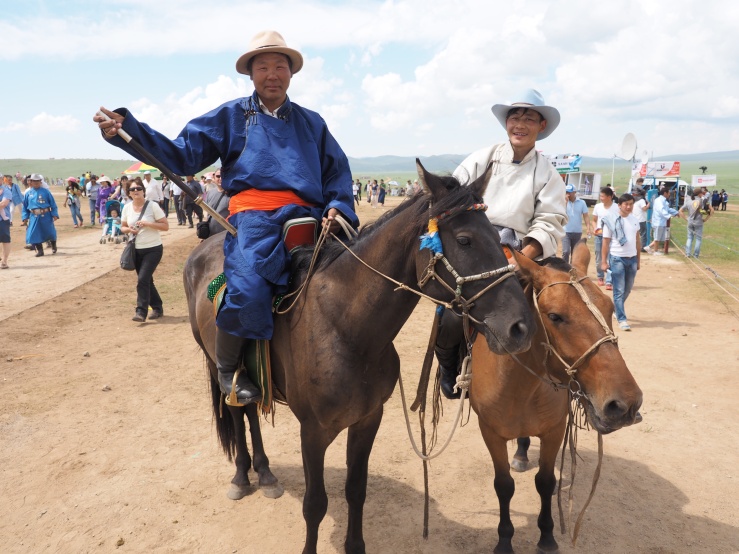
As was expected of a host in this country, I provided him with a hot drink and some gambir, which I had fried the previous day. He refused the sweets; pointing at his white, perfect teeth. After discovering that I had neither gun nor dog to protect me from the wolves and bears that were present in the park, he asked to join me. It was not possible to communicate a refusal and so I accepted. First, however, he would ride to collect his dog and tent, which he had left a few kilometers back. We were then to meet up at Zegst lake, positioned under Asralt Hairhan Uul (2800 m), the highest mountain in the Töv province.
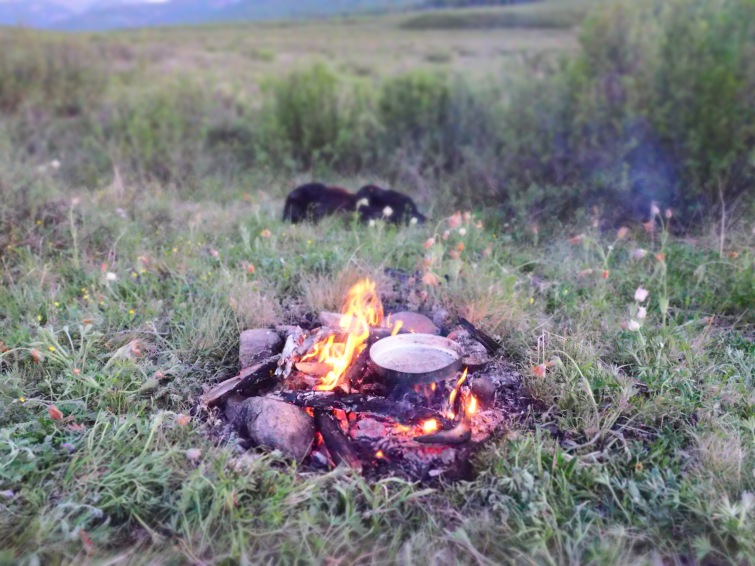
This day of travel would take me into the Khan Khentii strictly protected area. The temperatures were dropping as I travelled into higher terrain and storm clouds threatened overhead. Battling first through a pine forest, and then through a beautiful but stark alpine marsh system, I made slow progress towards the lake. I soon became navigationally ‘distracted’ by a solid-looking path and followed it too far west, finding myself deep in yet another forest. I was, however, rewarded by glorious views of the snow capped Asralt Hairhan, whose peak beckoned to me from the clouds. Soon the sky broke and under freezing cold raindrops and huge flashes of light, I was forced to make camp on a small patch of grass to the south of the mountain. I had only made it half way to the lake and would be camping alone again tonight, breaking my promise to meet the horseman.
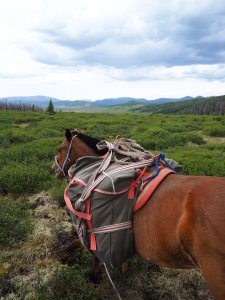
Day 14
I experienced one of the most challenging days of the trek today as I underestimated the warmth-sapping qualities of a combination of rain and knee-deep water. I was cold from the moment I exited my tent, but resolute to make it to the lake by evening. Throughout the day, waves of light, cold rain pulsed over the surrounding landscape and Asralt Hairhan was veiled in a brilliant white mist above me.
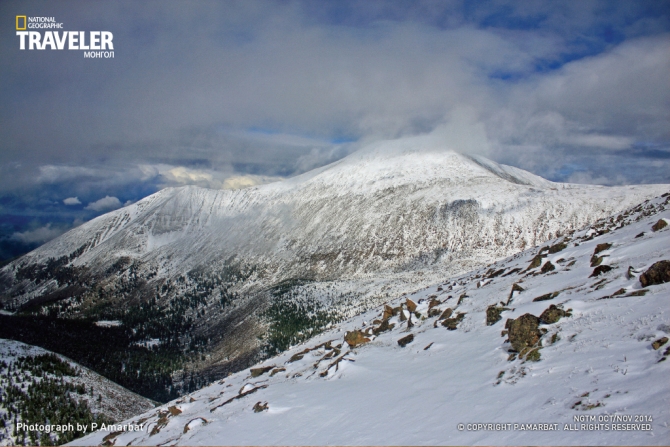
The fat brown horse had managed to escape from his halter last night, but the faithful animal was unwilling to abandon his friend, the white horse, and thus had remained in much the same position that I had left him in the day before.
After packing up camp, I headed northeast, deciding to stick to bearings rather than obvious paths. By about mid-day I was back on track but the landscape was incredibly disorientating and I found myself walking through deep marsh, drenching my pants to the knee. Once the great rolling mist fell into the valley, visibility was reduced to a couple of meters and finding clear routes for the horses and identifying markers on the map was near impossible.
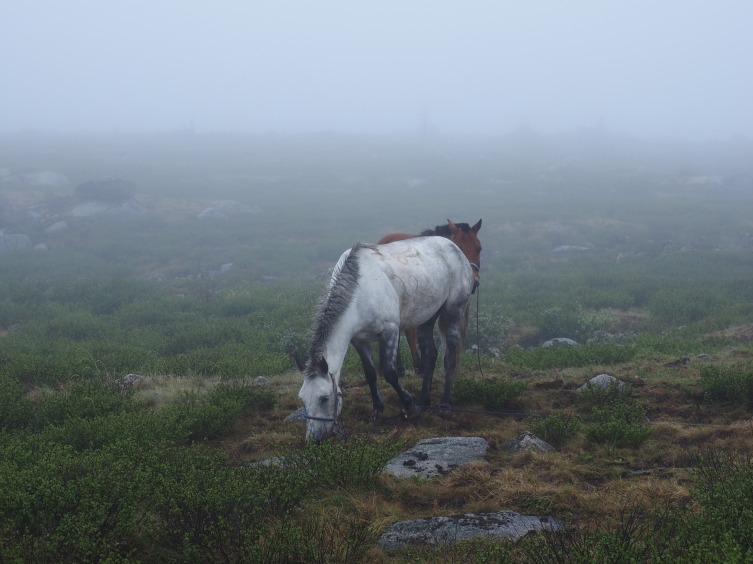
By early afternoon, I was growing weary and cold. I crossed a river filled with blocks of ice and lined with crunchy snow. The rain was light but continuous and the temperature was probably hovering around 10 degrees centigrade.
While wandering along the eastern side of the river, my horses stopped dead, braying nervously and pulling violently on the ropes. Their fear permeated the air between us and the electricity of the moment soon had my heart beating rapidly. I gazed through the mist, which although had cleared slightly, still restricted visibility to around 30 meters, and perceived a bulky shadow a little beyond the snowy banks on the opposite side of the water. A bear had come down to the river to drink, a beautiful sentry of the wilderness, a solitary hunter in the silent dream-world I found myself in today. The bear was brown and although mature in appearance, was much smaller than any I had seen on television or in America. Even so, I decided not to tempt fate. This was his domain and I was an uninvited visitor. As I backed my nervous horses away, his soft brown eyes appeared to meet mine for a moment and then he was gone, dissolving into the mist as quietly as he had first appeared.
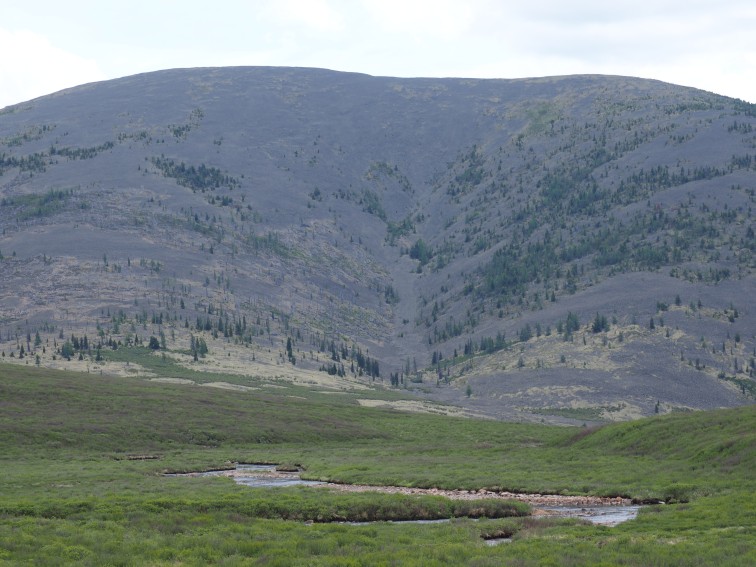
After stumbling blindly forward for an hour or so, the landscape opened, and the lake appeared before me. By this stage I was incredibly cold and so went about setting up my shelter as fast as my numb fingers allowed. The rain was sleeting down and my hair and was frozen into spikes.
A hot meal later and wearing all my remaining dry clothes, a down jacket and my sleeping bag, and I was still cold. The horses munched grass contently outside, wet and shivering slightly but still relatively oblivious to the frozen conditions.
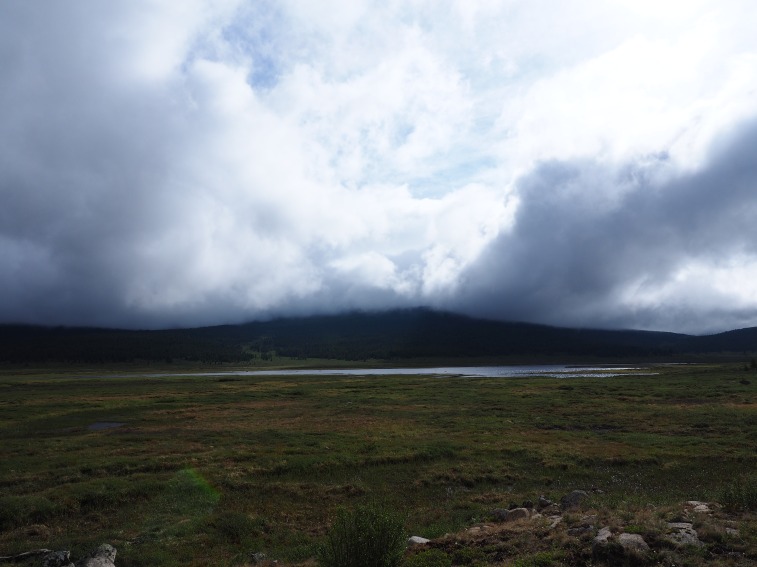
Day 15
Last night, I was roused from the warmth of my tent by horsey snorts of fear. Remembering the bear encountered earlier that day, my worries instantly went in that direction. I peaked out of my tent door with great apprehension, and after a quick visual sweep of the lake, spotted some kind of undulate drinking from the still waters. It was much larger than any farm animal, with great brown shaggy fur and when it finished drinking it ran along the sodden ground with the grace of a beast in total synchrony with its surroundings. Although antlerless, I was looking at a moose, either a cow or a young male that had not yet regrown its antlers following the long winter. Both bears and moose are extremely rare in this country, and so I counted myself as extremely lucky to encounter both of them, and on the same day.
When I rose that morning the mist was rising and slithers of blue sliced the grayness of they sky above. After packing up camp, I made good ground, leaving the lake behind me and navigating easily along the river. I was now heading back towards the entrance of Terelj National Park, and I already felt the memory of the previous day’s coldness falling from my mind.
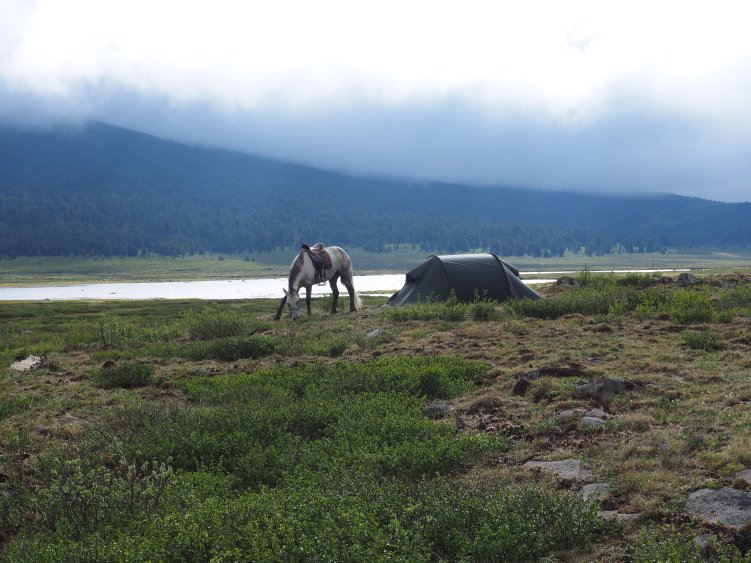
That afternoon, I led my horses over a boulder field, impatient with my progress on the safer but scrubbier path I had been following. The boulders were closely positioned, sized a few meters to a foot across and were slippery from the rain of the previous days. As I walked (on foot), I let my mind wander, hypnotized by the unaccustomed warmth of the day.
And this gap in thought was all it took.
The lead rope went taunt as my white horse slipped down into a hole, stuck up to his waist in the rocks. As he struggled vainly, a basketball sized bolder rolled towards him, wedging him further into the choss.
I was afraid his legs were broken, and a million horrible thoughts went through my head. Would I have to kill him if he was horribly disabled (movie generated images of men shooting their prize horse-gone-lame circulated through my mind)?
This was all my fault.
On the verge of panic, I fastened a rope around his belly and onto the packsaddle of the fat brown horse. Collectively we pulled at the poor horse and after a few tense minutes, he scrambled out from the hole. Almost as a testament to the toughness of the Mongolian horse, his injuries appeared minimal and my fears had come to naught.
The result of this experience led to two things. The first was an intense feeling of guilt. My horses were not just my mode of transport, my pack carriers, they were my friends and my negligence could have led to the severe disability of one of them. The second was a name; I would call the white horse ‘Odin’, after a memorable climb that required a scary move into and out of a deep cave, and after the Norse God who is often associated with death and healing and has been depicted healing horses on the battlefield.
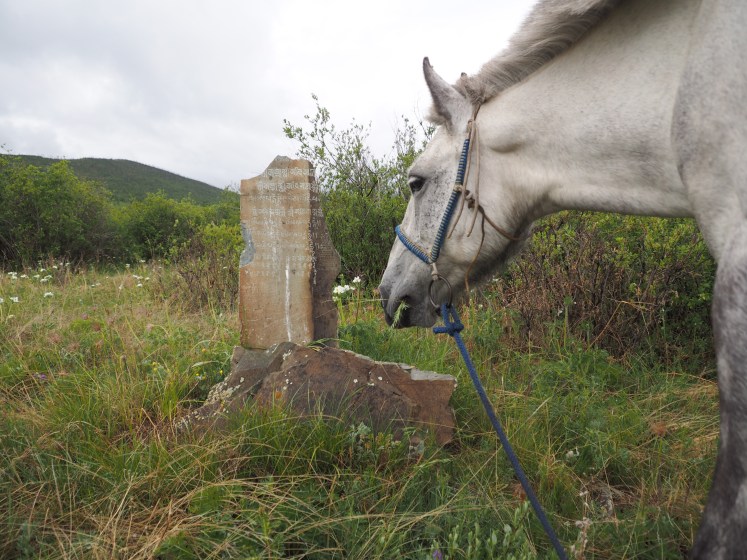
Tonight we camped by the junction of the Zaan and Ih Aliayn river. I dressed Odin’s wounds (a few minor scratches) with disinfectant and collected armfuls of rich grass from the banks of the river to offer up as an apology.
Day 16
A great peace settled over me as I walked today. The horses and I followed a clear stony path, crossing a few rivers bordered with open grass, rather than scrub. Wishing to rest the horses, and after stumbling on a wonderfully open plot of land around lunchtime, I unpacked camp and spent the day bathing in the river and laying under the sun with my horses. The bugs were all pervading, but there were a few moments between the transition from flies to mosquitoes where the landscape was silent.
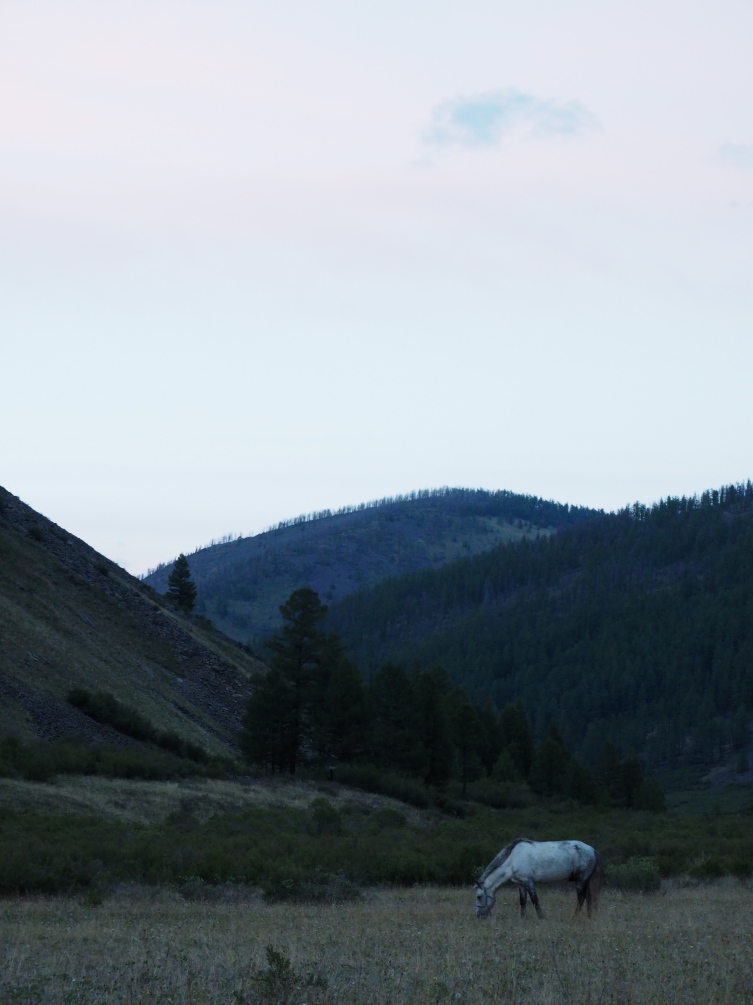
That night the baying of dogs woke me. In my opinion, some Mongolian dogs are far more frightening than any wolf or bear. The dogs are less fearful of humans, more curious and are prone to searching human camps for food. They are also more likely to carry disease, as they often survive on a diet of human faeces (charming!) and they can be affected by rabies. The Great Chinggis Khan himself was frightened of Mongolian dogs, so I believed that it was only logical to also survey them with a wary eye. My horses were, however, silent and relaxed and thus I knew that there was no danger in this situation. I fell asleep, intrusting my safety to the watchful eyes of my two steeds.
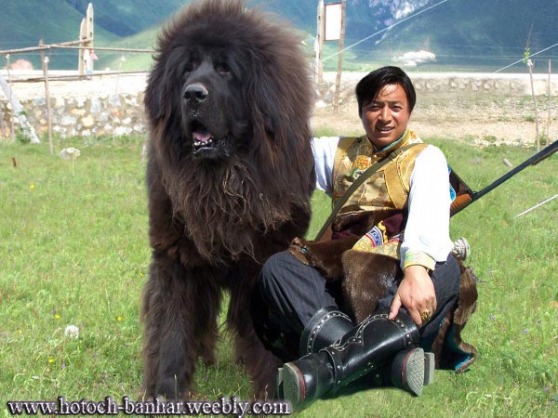
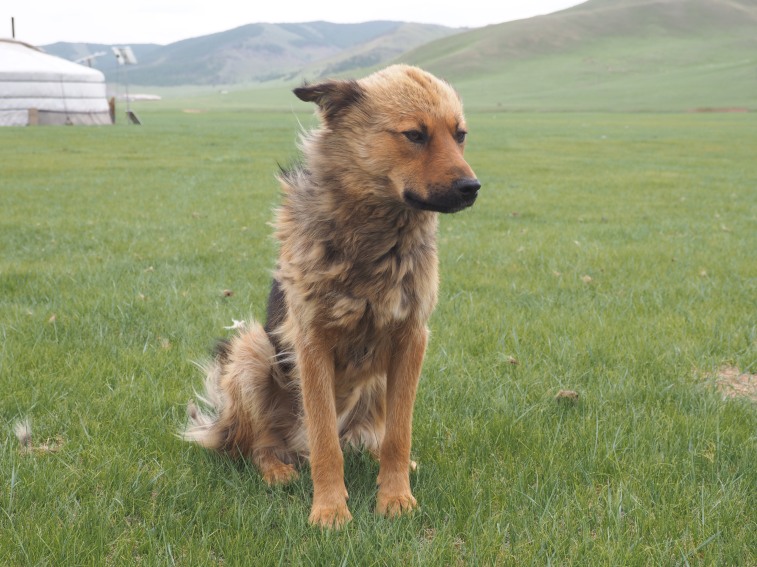
Day 17
I came to name the fat brown horse Number six, after the reliable and solid (but often cumbersome) number 6 camalot used in traditional climbing. He was an incredibly dependable horse, sticking by Odin even when left free to roam, but refused to budge in many situations, such as when I went to ride him away from his friend.
Today, we had a rest day, and I allowed the horses and I time to recover from the trials of the previous days. I made and cooked more gambir on my little stove and attempted to ride Number six to the river until he stopped dead, once out of site of Odin, and determinedly backed up all the way to camp, neighing loudly.
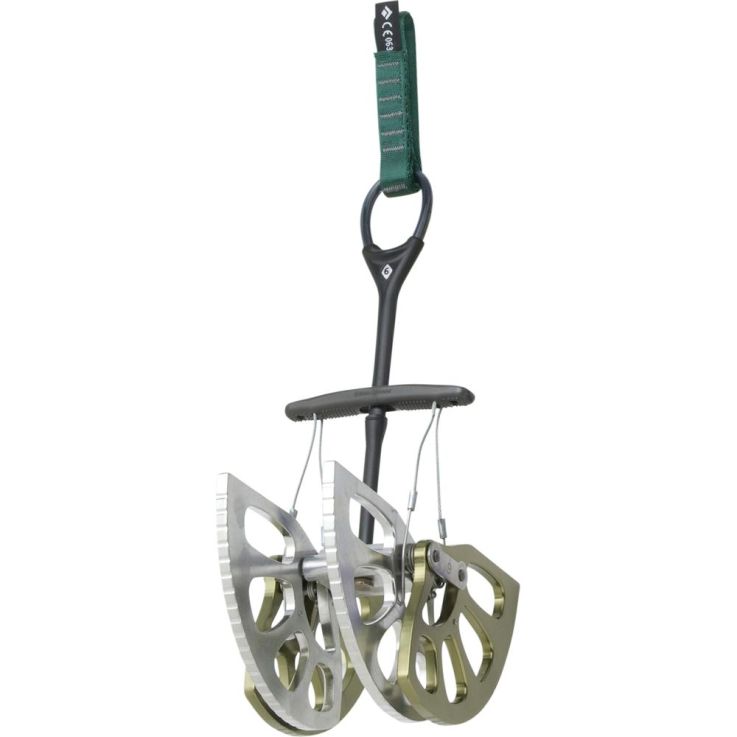
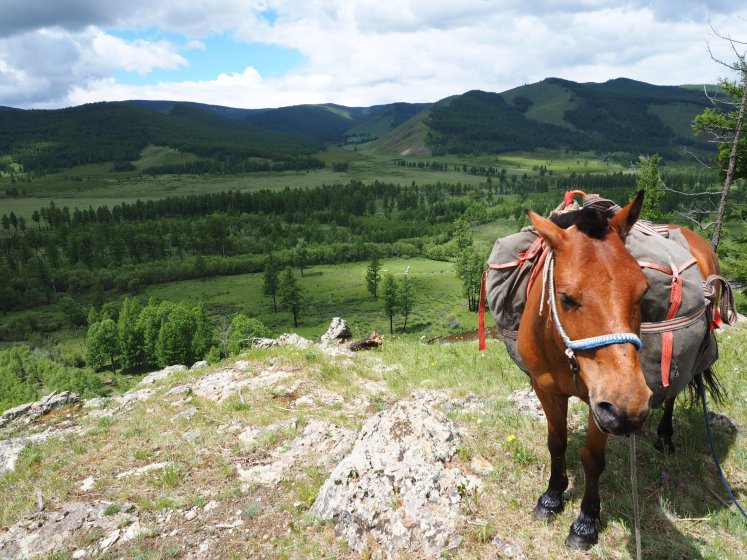
Day 18
This morning Odin refused to put weight on his back leg. His battle with the boulders had caught up with him. I faced two choices, to sit tight for a day and hope that he recovered, or to slowly start making my way out of the park and get help for him if the injury was still evident. Leaving him behind was not an option, us being the three musketeers and all. After gently stretching out his leg over the morning, I found that the injury was not as bad as it had first seemed. He soon walked on the limb without complaint or limp and we made good ground today, although the packsaddle started causing more problems to Number six as the rain set in again. Constant diligence prevented any more rub spots developing and all the old wounds had healed nicely following nightly disinfecting and cleaning.
We walked in continuous rain, but as we descended from the higher elevations the temperature warmed considerably. Everything was soaked, but my spirit remained intact.
Our path took us down the Zaan River, which eventually met the Terelj River. We camped a little past the junction, and hidden in my tent I cooked dinner. I slept early, hoping the constant rain would cease and that tomorrow would be warm and sunny. As it were, tomorrow we would exit the park, but before that I would have to contend with flooded rivers and dodgy scree slopes.
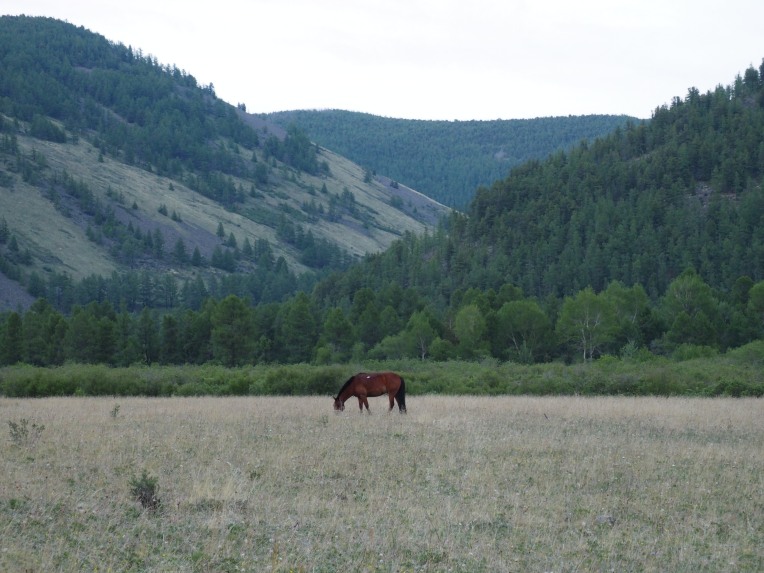
Reblogged this on Will the real reality please stand up!.
LikeLiked by 1 person